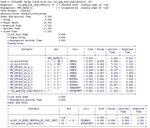harel222
Newbie level 5
Hi all,
Im using SoC Encounter, and after placement + optimization i analyzed time and got about 1700 setup violations.
The thing is, that apart from 6, all the violations are input-to-register, and almost all of them includes a port named PHY_DATA[*].
Example to a path from the report in the image.

And it continues with many path similar to this one.
It may be obvious (I'm a beginner), but what do you think i should do to solve it?
You can see in the second row in the table a delay of 4.888 ns which if i understand correctly is caused from PHY_DATA[5].. is this the problem?
Thanks a lot for your help.
Im using SoC Encounter, and after placement + optimization i analyzed time and got about 1700 setup violations.
The thing is, that apart from 6, all the violations are input-to-register, and almost all of them includes a port named PHY_DATA[*].
Example to a path from the report in the image.

And it continues with many path similar to this one.
It may be obvious (I'm a beginner), but what do you think i should do to solve it?
You can see in the second row in the table a delay of 4.888 ns which if i understand correctly is caused from PHY_DATA[5].. is this the problem?
Thanks a lot for your help.